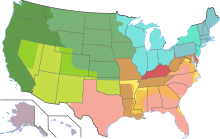|
Gradual emancipation (United States) Gradual emancipation was a legal mechanism used by some U.S. states to abolish slavery over some time, such as An Act for the Gradual Abolition of Slavery of 1780 in Pennsylvania.[1] HistoryIn the 16th century, Bartolomé de las Casas advocated ending enslavement. He stated that it was immoral, but there was pressure economically and politically to maintain slavery. Some of those who advocated for change wanted to end the transatlantic slave trade, because of how torturous it was, but still supported slavery. Others wanted to end slavery entirely.[2]  Abolition of slavery during or shortly after the American Revolution The Northwest Ordinance, 1787 Gradual emancipation in New York (starting 1799, ended 1827) and New Jersey (starting 1804, ended by Thirteenth Amendment, 1865) The Missouri Compromise, 1821 Effective abolition of slavery by Mexican or joint US/British authority Abolition of slavery by Congressional action, 1861 Abolition of slavery by Congressional action, 1862. Emancipation Proclamation as originally issued, 1 Jan 1863 Subsequent operation of the Emancipation Proclamation in 1863 Abolition of slavery by state action during the Civil War Operation of the Emancipation Proclamation in 1864 Operation of the Emancipation Proclamation in 1865 Thirteenth Amendment to the US constitution, 18 Dec 1865 Territory incorporated into the US after the passage of the Thirteenth Amendment The Age of Enlightenment of the late 17th century influenced increasing support for emancipation in the 18th century.[2] In the 1770s, Black people throughout New England began sending petitions to northern legislatures demanding freedom.[3] Pennsylvania's An Act for the Gradual Abolition of Slavery of 1780 was the first legislative enactment in the United States.[4] It specified that
Once the Pennsylvania residents were freed, they were supposed to be treated the same as indentured servants who were contracted for four years of service. For instance, they were to receive tools of their trade or other privileges.[4] Four other Northern states adopted policies to at least gradually abolish slavery: New Hampshire and Massachusetts in 1783, and Connecticut and Rhode Island in 1784. The Republic of Vermont had already limited slavery in its original constitution (1777), before it joined the United States as the 14th state in 1791. These state jurisdictions thus enacted the first abolition laws in the Americas.[3] By 1808, the importation of enslaved people was prohibited (though smuggling continued), and by the 1820s all Northern states enacted laws for either gradual or immediate emancipation.[5] By 1860, U.S. Census data showed that almost all Northern states had no slaves except for New Jersey which had enacted such gradual emancipation that there were still 18 slaves enumerated by the census.[6][circular reference] Starting in the early 19th century, the concept of gradual abolition spread from the US to Latin America, where it became known as Freedom of wombs. Abraham Lincoln proposed an amendment to the Constitution for gradual emancipation in 1861 and 1862, culminating with the Second Message to Congress in December 1862. However, he realized that immediate emancipation was what was needed, because there was increasing support for emancipation in the north and slaves helped the Confederates during the war. This led to the Emancipation Proclamation, which went into effect on January 1, 1863.[7] The Thirteenth Amendment to the United States Constitution was ratified at the end of the war, making slavery illegal in every state, and all enslaved people were freed.[8] See also
References
|